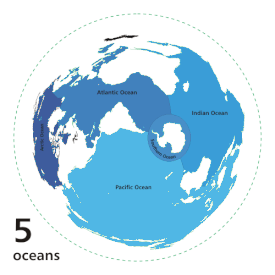World Ocean - Simple English Wikipedia, the free encyclopedia

| Earth's oceans (World Ocean) |
|---|
The world ocean, or global ocean is used to describe all the world's oceans as one large interconnected ocean. It is not a generally agreed term.
It is divided into the standard oceans: the Atlantic Ocean, Arctic Ocean, Indian Ocean, Pacific Ocean, and the proposed southern ocean around the Antarctic.
The world ocean is mainly the southern oceans. The Atlantic, Indian, and Pacific Oceans can be seen as bays or lobes going northward from the Southern Ocean. Farther north, the Atlantic opens into the Arctic Ocean, which is connected to the Pacific by the Bering Strait:
- The southern ocean would be the ocean surrounding Antarctica, generally the ocean south of sixty degrees south latitude. Parts of the Southern Ocean are covered in sea ice, the extent of which varies according to the season. The southern ocean is the second smallest of the five named oceans.
- The Atlantic Ocean, the second biggest, extends from the southern ocean between South America, Africa, North America and Europe, to the Arctic Ocean. The Atlantic meets the Indian Ocean south of Africa at Cape Agulhas.
- The Indian Ocean extends northward from the Southern Ocean to India, between Africa and Australia. The Indian Ocean joins the Pacific Ocean to the west, near Australia.
- The Pacific Ocean, the biggest of all, also reaches northward from the Southern Ocean to the Arctic Ocean. It is in the gap between Australia, Asia, North America and Oceania. The Pacific Ocean meets the Atlantic south of South America at Cape Horn.
- The Arctic Ocean is the smallest of the five. It joins the Atlantic near Greenland and Iceland, and joins the Pacific at the Bering Strait. It is on the North Pole, touching North America in the Western hemisphere and Scandinavia and Asia in the Eastern hemisphere. Parts of the Arctic Ocean are covered in sea ice, the extent of which varies according to the season.
The oceans of the world are not constant. Climate change happens, and so does continental drift over a much longer timescale.


 French
French Deutsch
Deutsch